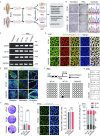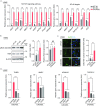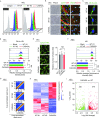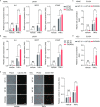Modeling CADASIL vascular pathologies with patient-derived induced pluripotent stem cells
- PMID: 30778920
- PMCID: PMC6418078
- DOI: 10.1007/s13238-019-0608-1
Modeling CADASIL vascular pathologies with patient-derived induced pluripotent stem cells
Erratum in
-
Correction to: Modeling CADASIL vascular pathologies with patient-derived induced pluripotent stem cells.Protein Cell. 2024 May 7;15(5):393. doi: 10.1093/procel/pwad059. Protein Cell. 2024. PMID: 38113127 Free PMC article. No abstract available.
Abstract
Cerebral autosomal dominant arteriopathy with subcortical infarcts and leukoencephalopathy (CADASIL) is a rare hereditary cerebrovascular disease caused by a NOTCH3 mutation. However, the underlying cellular and molecular mechanisms remain unidentified. Here, we generated non-integrative induced pluripotent stem cells (iPSCs) from fibroblasts of a CADASIL patient harboring a heterozygous NOTCH3 mutation (c.3226C>T, p.R1076C). Vascular smooth muscle cells (VSMCs) differentiated from CADASIL-specific iPSCs showed gene expression changes associated with disease phenotypes, including activation of the NOTCH and NF-κB signaling pathway, cytoskeleton disorganization, and excessive cell proliferation. In comparison, these abnormalities were not observed in vascular endothelial cells (VECs) derived from the patient's iPSCs. Importantly, the abnormal upregulation of NF-κB target genes in CADASIL VSMCs was diminished by a NOTCH pathway inhibitor, providing a potential therapeutic strategy for CADASIL. Overall, using this iPSC-based disease model, our study identified clues for studying the pathogenic mechanisms of CADASIL and developing treatment strategies for this disease.
Keywords: CADASIL; NF-κB; NOTCH; iPSC; vascular smooth muscle.
Figures










Similar articles
-
Peripheral arteriopathy caused by Notch3 gain-of-function mutation involves ER and oxidative stress and blunting of NO/sGC/cGMP pathway.Clin Sci (Lond). 2021 Mar 26;135(6):753-773. doi: 10.1042/CS20201412. Clin Sci (Lond). 2021. PMID: 33681964
-
Generation of a human iPSC line with Notch3 R133C mutation by CRISPR/Cas9: A tool for investigating CADASIL and therapeutic targets.Stem Cell Res. 2025 Apr;84:103678. doi: 10.1016/j.scr.2025.103678. Epub 2025 Feb 11. Stem Cell Res. 2025. PMID: 39983483
-
CADASIL mutations and shRNA silencing of NOTCH3 affect actin organization in cultured vascular smooth muscle cells.J Cereb Blood Flow Metab. 2012 Dec;32(12):2171-80. doi: 10.1038/jcbfm.2012.123. Epub 2012 Sep 5. J Cereb Blood Flow Metab. 2012. PMID: 22948298 Free PMC article. Clinical Trial.
-
Notch3 in Development, Health and Disease.Biomolecules. 2020 Mar 23;10(3):485. doi: 10.3390/biom10030485. Biomolecules. 2020. PMID: 32210034 Free PMC article. Review.
-
[Cerebral autosomal dominant arteriopathy with subcortical infarcts and leukoencephalopathy (CADASIL)].Rinsho Byori. 2009 Mar;57(3):242-51. Rinsho Byori. 2009. PMID: 19363995 Review. Japanese.
Cited by
-
Rescue of premature aging defects in Cockayne syndrome stem cells by CRISPR/Cas9-mediated gene correction.Protein Cell. 2020 Jan;11(1):1-22. doi: 10.1007/s13238-019-0623-2. Epub 2019 Apr 30. Protein Cell. 2020. PMID: 31037510 Free PMC article.
-
SIRT2 counteracts primate cardiac aging via deacetylation of STAT3 that silences CDKN2B.Nat Aging. 2023 Oct;3(10):1269-1287. doi: 10.1038/s43587-023-00486-y. Epub 2023 Oct 2. Nat Aging. 2023. PMID: 37783815
-
Bioengineering Systems for Modulating Notch Signaling in Cardiovascular Development, Disease, and Regeneration.J Cardiovasc Dev Dis. 2021 Sep 30;8(10):125. doi: 10.3390/jcdd8100125. J Cardiovasc Dev Dis. 2021. PMID: 34677194 Free PMC article. Review.
-
Use of iPSC-Derived Smooth Muscle Cells to Model Physiology and Pathology.Arterioscler Thromb Vasc Biol. 2024 Jul;44(7):1523-1536. doi: 10.1161/ATVBAHA.123.319703. Epub 2024 May 2. Arterioscler Thromb Vasc Biol. 2024. PMID: 38695171 Free PMC article. Review.
-
SARS-CoV-2 infection activating a novel variant of the NOTCH3 gene and subsequently causing development of CADASIL.Arch Med Sci. 2022 Apr 4;19(6):1781-1794. doi: 10.5114/aoms/146978. eCollection 2023. Arch Med Sci. 2022. PMID: 38058732 Free PMC article.
References
-
- Agrinier N, Thilly N, Boivin JM, Dousset B, Alla F, Zannad F. Prognostic value of serum PIIINP, MMP1 and TIMP1 levels in hypertensive patients: a community-based prospective cohort study. Fundam Clin Pharmacol. 2013;27:572–580. - PubMed
-
- Andersson ER, Lendahl U. Therapeutic modulation of Notch signalling–are we there yet? Nat Rev Drug Discov. 2014;13:357–378. - PubMed
-
- Andersson ER, Sandberg R, Lendahl U. Notch signaling: simplicity in design, versatility in function. Development. 2011;138:3593–3612. - PubMed
Publication types
MeSH terms
Substances
LinkOut - more resources
Full Text Sources
Molecular Biology Databases
Miscellaneous

